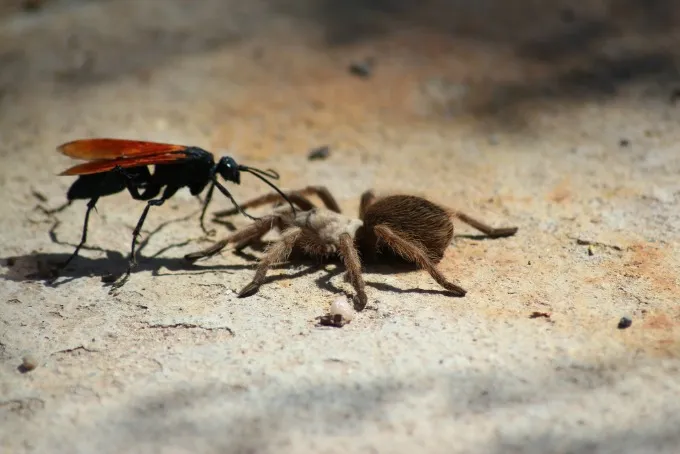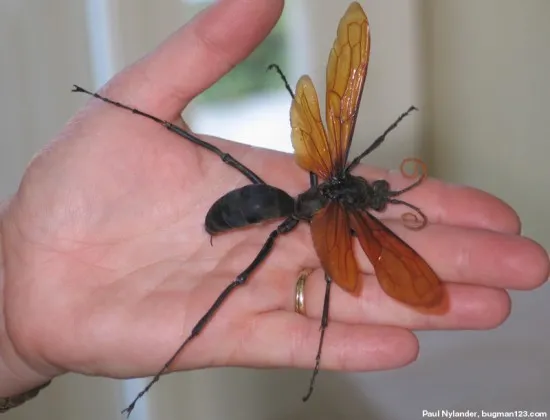Tarantula Hawk vs Spider: 5 Surprising Facts
The tarantula hawk, a formidable wasp, is infamous for its hunting prowess and the excruciating pain its sting inflicts. This insect, belonging to the Pompilidae family, engages in a dramatic confrontation with the colossal tarantula spider. These two creatures, one a predator and the other a prey, are locked in a constant struggle for survival in the vast, unforgiving wilderness. This blog post will delve into the surprising facts about this insect and spider, highlighting their key differences, behaviors, and the drama that unfolds between them. The tarantula hawk’s venom is one of the most potent in the insect world, while the tarantula spider’s sheer size and defensive mechanisms are a sight to behold. Join us as we explore the captivating world of these creatures and uncover the fascinating realities of their interactions, from their appearance and behavior to their hunting strategies and life cycles.
Appearance and Behavior
Tarantula Hawk

The tarantula hawk, with its striking appearance, is a sight to behold. Typically, it boasts a vibrant blue-black body contrasted by orange wings, allowing it to stand out in its environment. The female tarantula hawk is larger, reaching up to two inches in length, while the males are slightly smaller. Behaviorally, the female tarantula hawk is known for its solitary hunting habits, specifically targeting tarantula spiders. Their behavior is characterized by an unwavering determination and meticulous planning. The wasp methodically searches for its prey, often exploring burrows and crevices where spiders tend to hide. Once it finds a tarantula, it engages in an epic battle, aiming to paralyze the spider with its sting before dragging it to a prepared nest. This process shows their incredible strength, persistence, and the intricate hunting techniques that have made them the top predators in their world.
Spider
Tarantula spiders, on the other hand, come in a wide variety of sizes and appearances. These hairy, robust spiders are some of the largest in the world, and their appearance is just as diverse as their habitats. From the brown and tan hues of the North American tarantulas to the vibrant colors of some South American species, these spiders display an impressive range of physical characteristics. Behaviorally, tarantulas are primarily nocturnal hunters, lying in wait for unsuspecting prey. They are known for their slow movements and defensive postures, often raising their front legs to deter potential threats. Their primary defense mechanisms include the use of urticating hairs, which they flick at predators, causing intense irritation. Moreover, their size and powerful fangs allow them to defend themselves against various threats, including other predators. The spider’s survival strategy revolves around a combination of ambush tactics and effective defense mechanisms, making them formidable opponents in the wild.
Venom and Sting
Tarantula Hawk

The tarantula hawk’s venom is known for causing one of the most painful stings in the world. The sting is not typically lethal to humans but causes intense, excruciating pain that can last for several minutes. This pain is described by many as an experience that can disrupt daily activities, causing significant distress. This paralyzing agent serves a crucial role in the tarantula hawk’s hunting strategy. The wasp uses the sting to immobilize the tarantula spider. The venom is designed to subdue the spider, allowing the wasp to drag its prey back to its nest. The venom’s composition is highly sophisticated and specifically targets the nervous system, ensuring that the spider remains alive but paralyzed. The tarantula hawk’s sting is a remarkable example of evolutionary adaptation, demonstrating the effectiveness of the wasp’s predatory methods.
Spider
Tarantula spiders also possess venom, though its effects on humans are generally mild compared to the tarantula hawk’s sting. Their venom is primarily used to subdue their prey, such as insects and small animals, and it aids in the digestive process. The venom contains a complex mixture of toxins that can cause localized pain, swelling, and muscle cramps. In addition to venom, tarantulas have other defense mechanisms, including their fangs and urticating hairs. The fangs are used for biting and injecting venom, while the urticating hairs are small barbs that can be flicked at potential threats, causing irritation. The tarantula’s defenses work together to protect them from predators and ensure their survival. Their venom, while less potent than the tarantula hawk’s, is still an effective tool for hunting and self-preservation.
Hunting and Prey
Tarantula Hawk

The tarantula hawk is a specialist predator, primarily targeting tarantula spiders. The female tarantula hawk meticulously searches for tarantulas, often in their burrows or other hiding places. Once a tarantula is located, the wasp engages in a fierce battle, aiming to paralyze the spider with its sting. After subduing the tarantula, the wasp drags the paralyzed spider to a prepared nest, often a burrow or a pre-existing cavity. In the nest, the wasp lays a single egg on the spider’s abdomen, which is its prey. The larva hatches and feeds on the paralyzed spider, slowly consuming it from the inside out. This hunting strategy is an intricate example of predatory behavior and survival in the wild. The wasp’s ability to locate, subdue, and utilize the tarantula spider underscores its role as a highly effective predator.
Spider
Tarantula spiders are ambush predators, mainly hunting insects and other small invertebrates. They lie in wait, using their keen senses to detect the movement of potential prey. When a suitable victim comes within striking distance, the spider swiftly pounces, injecting venom through its fangs. The venom quickly immobilizes the prey, allowing the spider to begin its meal. The diet of tarantulas includes a wide variety of insects, with some larger species also preying on small vertebrates, such as lizards and rodents. The spider’s success as a predator is based on its ambush tactics, venomous bite, and ability to adapt to various environments. This hunting method, combined with the spider’s large size and defensive capabilities, ensures its survival in a world filled with predators and threats.
Life Cycle and Reproduction
Tarantula Hawk

The life cycle of the tarantula hawk begins with the female wasp’s quest to find and subdue a tarantula spider. After paralyzing the spider, the wasp drags it to a prepared nest, where it lays a single egg on the spider’s abdomen. Once the egg hatches, the larva feeds on the paralyzed spider from the outside. The larva slowly consumes the spider, growing and developing until it reaches the pupal stage. The pupa forms inside the spider’s exoskeleton, where it undergoes metamorphosis, transforming into an adult wasp. The emergence of the adult wasp marks the completion of its life cycle, which is now prepared to repeat the process by hunting, laying eggs, and starting the cycle over again. This entire process is a testament to the meticulous planning and efficiency of the tarantula hawk’s survival strategy.
Spider
The tarantula spider’s life cycle includes several stages, beginning with egg production. The female tarantula lays hundreds of eggs in a silken egg sac, which she guards diligently. Once the eggs hatch, the spiderlings remain close to their mother for a short period, learning essential survival skills. As they grow, the spiderlings molt, shedding their exoskeletons to accommodate their increasing size. This process, known as molting, continues throughout the spider’s life. The spider typically reaches adulthood over several years, and their lifespan can range from several to over 20 years, depending on the species and sex. Throughout their lifespan, tarantulas continue to hunt, mate, and reproduce, ensuring the continuation of their species.
Habitat and Distribution
Tarantula Hawk

Tarantula hawks are found in various regions around the world. They are particularly common in the southwestern United States, where they inhabit deserts and arid environments. They can also be found in parts of Central and South America. The presence of tarantula hawks depends largely on the abundance of tarantula spiders, their primary prey. These wasps prefer warm, sunny environments with sandy soil and open spaces, providing them with ideal hunting grounds and nesting sites. The distribution of tarantula hawks underscores their dependence on the existence of tarantula spiders, and the overall health of the ecosystems they inhabit. The tarantula hawk’s habitat reflects their essential role in regulating the spider population and maintaining ecological balance.
Spider
Tarantula spiders are found in a wide variety of habitats. They are primarily located in warmer climates around the globe. They can be found in deserts, grasslands, forests, and tropical environments. Their ability to adapt to various conditions allows them to thrive in diverse ecosystems. These spiders are often found in burrows, under rocks, or within the foliage, where they can hide and ambush their prey. The distribution of tarantula spiders is closely linked to the climate and availability of suitable habitats. Their presence contributes to the complexity of the ecosystems, playing a role in regulating insect populations and serving as prey for other animals. This demonstrates the adaptability and ecological significance of tarantula spiders.
